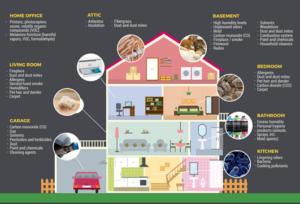Towards a better understanding of indoor air quality in the home
The World Health Organisation (WHO) recently stated that exposure to indoor and outdoor air pollution was one of the greatest risks to human health, and that improving air quality was necessary to reduce the global incidence and impact of diseases such as lung cancer, stroke, and asthma. Recognition of the significance of exposure to pollution indoors has grown over the last thirty years, given we spend around 90% of our time indoors in high income countries like the UK. However, compared to outdoor air quality, there is still relatively little known about the air we breathe in our homes.
This studentship will address this knowledge gap through an exploration of indoor air quality (IAQ) in a new, globally unique test facility at York – the INTERIORS (An INTERdisciplinary Facility for IndOoR Air Quality ReSearch) facility. INTERIORS will be used to quantify the emission rates of speciated pollutants from key indoor products (e.g. cleaning products, air-fresheners, building materials), understand how these emissions and resulting concentrations are affected by ventilation characteristics, house design, furnishings, chemical transformations and occupant behaviour, and how emissions from indoor materials vary over time and in realistic environments. Concurrent outdoor measurements of all pollutants will also be made, allowing investigation of the exchange of pollutants between indoors and outdoors.
As part of the INTERIORS operation, we will be monitoring the concentrations of a range of key pollutants such as particulate matter, carbon monoxide, ozone, nitrogen oxides, nitrous acid, and volatile organic compounds including formaldehyde. We will undertake these measurements in phases as the facility is constructed (completion due spring 2025), decorated and furnished, and finally, used for typical occupant activities like cooking and cleaning. For the first time, it will be possible to quantify how resultant IAQ relates to each of these components of a house separately and also, over the long-term. This information will then allow us to design appropriate mitigation strategies that lead to improved IAQ in the future.
The studentship will involve participating in these measurements, undertaking calibration and data analysis and using the data to drive an existing indoor air chemistry model, called INCHEM-Py. The model analysis will allow further insight into the indoor air chemistry processing that is simply not possible at the moment through existing measurement technology. The student will also be expected to present their data at national and international conferences, and to prepare their results for publication. They will be supported in these activities by their supervisors and also take advantage of the wide range of training opportunities available in the home departments of the supervisors, as well as more widely within the National Centre for Atmospheric Science and the University.

Figure 1: Architect’s drawing of the front elevation of the INTERIORS facility.

Figure 2: Primary sources of air pollution (https://yellowbluetech.com/docs/sources-of-indoor-air-pollutions.pdf)

Figure 3: INTERIORS site on Heslington East Campus.
